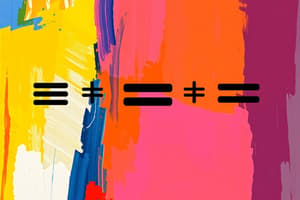Podcast
Questions and Answers
What is the branch of mathematics that uses symbols to represent numbers and quantities?
What is the branch of mathematics that uses symbols to represent numbers and quantities?
Algebra
What are symbols used to represent unknown values in algebra called?
What are symbols used to represent unknown values in algebra called?
Variables
Constants are fixed values that do not change.
Constants are fixed values that do not change.
True (A)
If 'a' equals 'b', what happens when we add 'c' to both sides of the equation?
If 'a' equals 'b', what happens when we add 'c' to both sides of the equation?
What is the name of the property that allows us to multiply both sides of an equation by the same value without changing its equality?
What is the name of the property that allows us to multiply both sides of an equation by the same value without changing its equality?
What is the general form of a linear equation?
What is the general form of a linear equation?
What is the process involved in solving linear equations?
What is the process involved in solving linear equations?
When multiplying or dividing both sides of an inequality by a negative number, the inequality sign must be flipped.
When multiplying or dividing both sides of an inequality by a negative number, the inequality sign must be flipped.
What are equations that have more than one variable called?
What are equations that have more than one variable called?
The graph of a linear equation in two variables is always a straight line.
The graph of a linear equation in two variables is always a straight line.
What does an exponent represent?
What does an exponent represent?
What is the general form of a quadratic equation?
What is the general form of a quadratic equation?
What are the solutions to a quadratic equation called?
What are the solutions to a quadratic equation called?
What is a relationship where each input value has only one output value called?
What is a relationship where each input value has only one output value called?
What is the notation used to represent a function?
What is the notation used to represent a function?
The graph of a quadratic function is always a straight line.
The graph of a quadratic function is always a straight line.
What is the set of all possible input values for a function called?
What is the set of all possible input values for a function called?
What is the process called when solving systems of equations by finding points common to all equations?
What is the process called when solving systems of equations by finding points common to all equations?
What are square roots, cube roots, and other roots referred to as?
What are square roots, cube roots, and other roots referred to as?
It is possible to convert between radical and exponential forms of expressions.
It is possible to convert between radical and exponential forms of expressions.
What is the name of the coordinate system used in coordinate geometry?
What is the name of the coordinate system used in coordinate geometry?
What does the slope of a line represent?
What does the slope of a line represent?
What kind of sequences have a constant difference between consecutive terms?
What kind of sequences have a constant difference between consecutive terms?
What kind of sequences involve multiplying consecutive terms by a constant value?
What kind of sequences involve multiplying consecutive terms by a constant value?
Flashcards
Algebra
Algebra
Branch of math using symbols (variables) to represent numbers and quantities.
Variable
Variable
A symbol (usually a letter) representing an unknown value.
Constant
Constant
A fixed value that doesn't change.
Addition Property of Equality
Addition Property of Equality
Signup and view all the flashcards
Subtraction Property of Equality
Subtraction Property of Equality
Signup and view all the flashcards
Multiplication Property of Equality
Multiplication Property of Equality
Signup and view all the flashcards
Division Property of Equality
Division Property of Equality
Signup and view all the flashcards
Linear Equation
Linear Equation
Signup and view all the flashcards
Linear Inequality
Linear Inequality
Signup and view all the flashcards
Solving Equations
Solving Equations
Signup and view all the flashcards
Solving Inequalities
Solving Inequalities
Signup and view all the flashcards
Function
Function
Signup and view all the flashcards
Function Notation
Function Notation
Signup and view all the flashcards
Quadratic Equation
Quadratic Equation
Signup and view all the flashcards
Systems of Equations
Systems of Equations
Signup and view all the flashcards
Coordinate Geometry
Coordinate Geometry
Signup and view all the flashcards
Slope
Slope
Signup and view all the flashcards
x-intercept
x-intercept
Signup and view all the flashcards
y-intercept
y-intercept
Signup and view all the flashcards
Polynomial
Polynomial
Signup and view all the flashcards
Arithmetic Sequence
Arithmetic Sequence
Signup and view all the flashcards
Geometric Sequence
Geometric Sequence
Signup and view all the flashcards
Study Notes
Basic Algebra Concepts
- Algebra is a branch of mathematics that uses symbols (variables) to represent numbers and quantities.
- Variables allow for the generalization of mathematical relationships and the solution of equations.
- Variables are typically represented by letters of the alphabet (e.g., x, y, z).
- Constants are fixed values, not variables.
Properties of Equality
- Addition Property of Equality: If a = b, then a + c = b + c. (Adding the same value to both sides of an equation maintains equality).
- Subtraction Property of Equality: If a = b, then a – c = b – c. (Subtracting the same value from both sides maintains equality).
- Multiplication Property of Equality: If a = b, then ac = bc. (Multiplying both sides by the same value maintains equality).
- Division Property of Equality: If a = b and c ≠ 0, then a/c = b/c. (Dividing both sides by the same non-zero value maintains equality).
Solving Linear Equations
- Linear equations have the form ax + b = c, where 'a', 'b', and 'c' are constants and 'x' is the variable.
- Solve for 'x' by using the properties of equality to isolate the variable.
- Combine like terms on each side of the equation.
- Add or subtract constants to move them to the opposite side of the equation.
- Multiply or divide by constants to isolate the variable.
Solving Linear Inequalities
- Linear inequalities have the form ax + b > c, ax + b < c, ax + b ≥ c, or ax + b ≤ c.
- The process for solving inequalities is similar to solving equations but with a crucial difference.
- When multiplying or dividing by a negative number, flip the inequality sign.
Linear Equations with Several Variables
- Equations can have more than one variable.
- Systems of equations.
- Solve for a specific variable in terms of the other variables.
- Use substitution or elimination methods to solve systems of equations and inequalities.
- Graphing linear equations in two variables.
- The graph of a linear equation in two variables is a straight line.
- Finding x and y intercepts.
Exponents and Polynomials
- Exponents represent repeated multiplication.
- Polynomials are expressions consisting of variables and constants, combined with operations like addition, subtraction, and multiplication.
- Basic operations with polynomials (addition, subtraction, multiplication).
- Factoring quadratic expressions: Finding factors of quadratic equations
Quadratic Equations
- Quadratic equations have the form ax² + bx + c = 0, where 'a', 'b', and 'c' are constants and 'x' is the variable.
- Solving quadratic equations using factoring, completing the square, and the quadratic formula.
- Finding roots or solutions (the 'x' values that make the equation true).
Functions
- A function is a relation where each input value has only one output value.
- Function notation (f(x)).
- Different types of functions (linear, quadratic, etc.).
- Graphing functions on a coordinate plane.
- Finding the domain and range of a function.
Systems of Equations
- Two or more equations considered together.
- Solutions are points in common on the graph for all equations.
- Solving systems by graphing, substitution, and elimination methods.
- Special cases (infinite solutions, no solutions).
Radicals and Rational Exponents
- Square roots, cube roots, and other roots.
- Simplifying radical expressions.
- Operations with radicals.
- Converting between radical and exponential forms.
Coordinate Geometry
- Cartesian coordinate system (x-y plane)
- Graphing points, lines, and other geometric shapes.
- Finding the distance between two points.
- Finding the midpoint of a line segment.
- Understanding slope and its applications in linear equations and lines.
Sequences and Series
- Understand the concepts of arithmetic sequences and geometric sequences.
- Calculate terms in a sequence.
- Calculate sums of sequences.
Studying That Suits You
Use AI to generate personalized quizzes and flashcards to suit your learning preferences.




